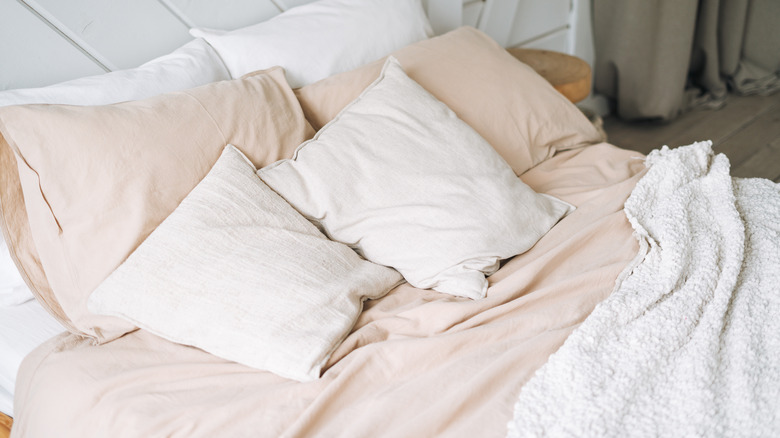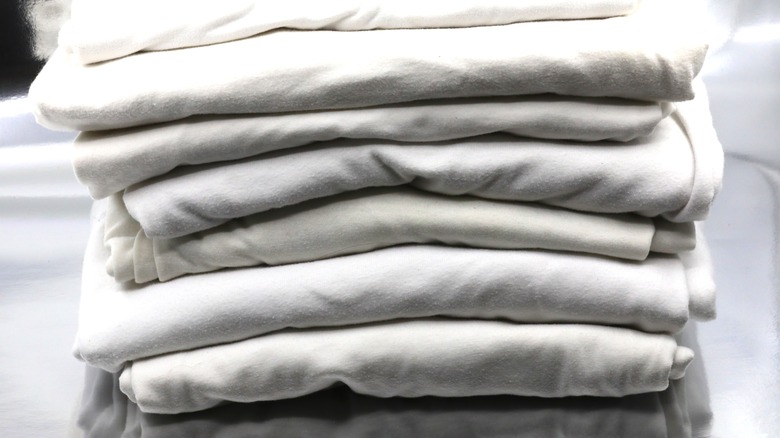Not All Cotton Sheets Are Made Equal. Here's How To Tell Them Apart
If you were to walk into the bedding aisle, close your eyes, and pick something out, there's a good chance it would be made of cotton — that's how common cotton bedsheets are. But whether your mystery sheets would feel silky, fuzzy, or crisp is another matter. Cotton sheet varieties can feel like totally different materials, depending on the cotton type, weave or knit style, and thread count.
Cotton comes from the seed of the cotton plant. It's been in use for thousands of years and continues to be the second-most common fiber in the world thanks to its natural breathability, comfort, and sturdiness. It's also versatile: Different types of cotton have different properties and can be turned into a range of fabrics. This means that when it comes to cotton sheets, you have lots of options to choose from.
The most common type of cotton is upland cotton. If your sheets don't specify the type, they are likely made from this variety. It has short "staples" or fibers, which results in a coarser fabric that is durable and affordable. By contrast, Egyptian and Pima cotton are made from a cotton variety with long staples, resulting in a softer fabric that is less likely to pill and wrinkle but also more expensive. Terms like "Egyptian cotton" aren't regulated, so check whether your sheets specify the staple length, since that's what makes a real difference.
Cotton weaves and knits explained
Cotton can take the form of dozens of different fabrics depending on how it's woven or knitted, from canvas to corduroy to denim. For bedsheets, most weave and knit styles include jersey, flannel, percale, sateen, and twill. Each of these has a unique feel. Your choice of fabric is a matter of personal preference and comfort.
Jersey is stretchy and soft like a comfy T-shirt; it's one of the best types of bedsheets for every season since it stays cool in summer and warm in winter. Flannel sheets keep you warm and cozy in winter thanks to their thick, fuzzy feel. Sateen has a smooth, silky sheen, while percale is crisp, matte, and cool like a fresh button-down. Lastly, twill is sturdy and heavy; it's the same material as denim.
Keep in mind that other materials aside from cotton can also be used for these weave and knit styles. Some fabrics are made with a blend of multiple materials. Jersey, for example, is typically blended with synthetic materials like polyester. Flannel and percale may also be made from other materials or blends.
Thread counts and sustainability of cotton sheets
Thread count also makes a difference in how cotton sheets feel, though not as much as the cotton type and weave. A higher thread count — i.e. the number of threads in one square inch of woven fabric – usually means a softer, smoother, and more durable fabric, but too high and the fabric would be dense and unbreathable. So, if you see suspiciously high thread-count bedsheets, there's probably some misleading marketing going on. Quality cotton sheets usually have a thread count ranging from 200 to 400, but it may be higher depending on the weave style. Sateen thread counts may go up to 600, for example, while that's not the case for percale.
Other considerations include sustainability and sourcing. As such a major crop, cotton takes a toll on the environment, and it's typically grown from genetically modified seeds with the help of synthetic fertilizers and pesticides. By contrast, organic cotton is not. The trade-off is that organic sheets may have a rougher texture. If you'd prefer to buy organic, there should be a Global Organic Textile Standard (GOTS) or Organic Content Standard (OCS) certification on the label. You can also choose to buy sheets made with U.S.-grown cotton. For example, one American-grown subtype of Pima cotton, Supima cotton, must be certified by the Supima Association.


